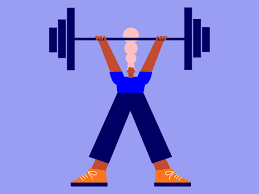Discover why “quality over quantity” matters in fitness. Learn how excessive exercise can hinder progress and how to strike the perfect balance for optimal results.
When it comes to achieving fitness goals, the mantra “more is better” often seems appealing. However, when applied to exercise, this approach can backfire. The key to long-term success lies in quality over quantity, as too much exercise can do more harm than good. Overtraining, injury risk, and diminishing returns are just a few potential downsides of over-exercising. In this article, we’ll explore why excessive exercise can hinder progress and how focusing on quality can lead to better results.
The Concept of “Quality Over Quantity”
What Does “Quality Over Quantity” Mean in Fitness?
In fitness, “quality over quantity” emphasizes the importance of effective, focused, and well-structured workouts rather than sheer volume. It means:

- Performing exercises with proper form.
- Prioritizing recovery and rest.
- Tailoring workouts to specific goals and abilities.
Focusing on quality ensures that every rep, set, and session contributes meaningfully to your progress.
Why Too Much Exercise Can Hinder Progress
1. Increased Risk of Overtraining Syndrome (OTS)
Overtraining occurs when the body doesn’t get enough rest between workouts. Symptoms include:
- Chronic fatigue
- Decreased performance
- Mood swings
Why It Matters: Without proper recovery, your muscles, joints, and cardiovascular system don’t have time to repair and strengthen, leading to plateaus or even regression.
2. Higher Likelihood of Injury
Excessive exercise increases the risk of repetitive strain injuries such as:
- Tendinitis
- Stress fractures
- Joint inflammation
Why It Matters: Injuries can derail your fitness journey and take weeks or months to heal, negating any perceived progress from overexercising.
3. Diminishing Returns
Exercise stimulates muscle growth, cardiovascular health, and endurance, but there’s a limit to how much the body can adapt. Over-exercising can:
- Lead to hormonal imbalances (e.g., increased cortisol levels).
- Reduce the effectiveness of workouts.
Why It Matters: Beyond a certain point, additional exercise doesn’t equate to additional benefits. In fact, it can hinder performance.
4. Mental Burnout
Excessive training can take a toll on mental health, leading to:
- Decreased motivation
- Anxiety about missed workouts
- Poor mood
Why It Matters: A sustainable fitness routine is one that nurtures both physical and mental well-being.
Signs You Might Be Overdoing It
Physical Signs
- Persistent muscle soreness
- Frequent injuries
- Decreased strength or endurance
Psychological Signs
- Lack of motivation
- Insomnia or poor sleep quality
- Feelings of irritability or depression
Performance Signs
- Plateauing results despite increased effort
- Slower recovery times
- Reduced ability to complete workouts
Strategies to Focus on Quality
1. Set Clear Goals
Determine what you want to achieve—whether it’s strength, endurance, or weight loss—and design a program that aligns with those goals.
2. Prioritize Proper Form
Correct technique ensures that you target the right muscles and reduce injury risk. Consider working with a trainer or using instructional videos for guidance.
3. Incorporate Rest Days
Rest days are crucial for recovery. Schedule at least one or two days per week for complete rest or light activities like yoga or walking.
4. Use Progressive Overload Wisely
Gradually increase intensity, weight, or volume to challenge your body without overwhelming it. Monitor progress and adjust as needed.
5. Listen to Your Body
Pay attention to signs of fatigue, soreness, or discomfort. If something feels off, scale back or modify your routine.
The Role of Recovery in Fitness Progress
Recovery is where the magic happens. During rest, your body:
- Repairs muscle fibers
- Replenishes energy stores
- Strengthens connective tissues
Tips for Optimal Recovery:
- Get 7-9 hours of sleep per night.
- Stay hydrated and maintain a balanced diet.
- Consider active recovery techniques like stretching or foam rolling.
Benefits of Quality-Focused Workouts
1. Better Results in Less Time
Efficient workouts mean you achieve more in less time, leaving room for other priorities.
2. Reduced Injury Risk
Focusing on form and recovery minimizes strain on joints and muscles.
3. Improved Mental Health
Balanced exercise reduces stress and enhances mood, fostering a positive relationship with fitness.
In fitness, more isn’t always better. Prioritizing quality over quantity allows you to achieve sustainable progress, avoid injury, and maintain a healthy balance. By focusing on effective workouts, proper recovery, and mindful practices, you can maximize your fitness journey and enjoy lasting benefits.
FAQ
1. How much exercise is too much?
Exceeding 6-7 intense sessions per week without adequate rest may lead to overtraining. Listen to your body to find the right balance.
2. Can overtraining affect weight loss?
Yes. Overtraining can increase cortisol levels, which may hinder fat loss and lead to muscle breakdown.
3. How can I tell if I’m overtraining?
Common signs include persistent fatigue, decreased performance, and increased susceptibility to injury.
4. What is the ideal exercise frequency?
For most individuals, 3-5 sessions per week of moderate to intense activity, combined with rest days, works well.
5. Is rest as important as exercise?
Absolutely. Rest is essential for recovery, muscle growth, and overall performance improvement.
By adopting a quality-over-quantity approach, you can transform your fitness routine into a sustainable and rewarding journey.